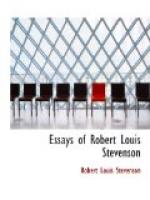[Note 8: I am happier where it is tame and fertile, and not readily pleased without trees. Notice the kind of country he begins to describe in the next paragraph. Is there really any contradiction in his statements?]
[Note 9: Like David before Saul. David charmed Saul out of his sadness, according to the Biblical story, not with nature, but with music. See I Samuel XVI. 14-23. But in Browning’s splendid poem, Saul (1845), nature and music are combined in David’s inspired playing.
“And I first played the tune all our sheep know,” etc.]
[Note 10: The sermon in stones. See the beginning of the second act of As You Like It, where the exiled Duke says,
“And this our life exempt from public
haunt
Finds tongues in trees, books in the running
brooks,
Sermons in stones and good in everything.”
It is not at all certain that Shakspere used the word “sermons” here in the modern sense; he very likely meant merely discourses, conversations.]
[Note 11: Wuthering Heights. The well-known novel (1847) by Emily Bronte (1818-1848) sister of the more famous Charlotte Bronte. The “little summer scene” Stevenson mentions, is in Chapter XXIV.]
[Note 12: A solitary, spectacled stone-breaker. To the pedestrian or cyclist, no difference between Europe and America is more striking than the comparative excellence of the country roads. The roads in Europe, even in lonely and remote districts, where one may travel for hours without seeing a house, are usually in perfect condition, hard, white and absolutely smooth. The slightest defect or abrasion is immediately repaired by one of these stone-breakers Stevenson mentions, a solitary individual, his eyes concealed behind large green goggles, to protect them from the glare and the flying bits of stone.]
[Note 13: Ashamed and cold. An excellent example of what Ruskin called “the pathetic fallacy.”]
[Note 14: The foliage is coloured like foliage in a gale. Cf. Tennyson, In Memoriam, LXXII:—
“With blasts that blow the poplar white.”]
[Note 15: Wordsworth, in a beautiful passage. The passage Stevenson quotes is in Book VII of The Prelude, called Residence in London.]
[Note 16: Cologne Cathedral, the great unfinished marvel by the Rhine. This great cathedral, generally regarded as the most perfect Gothic church in the world, was begun in 1248, and was not completed until 1880, seven years after Stevenson wrote this essay.]
[Note 17: In a golden zone like Apollo’s. The Greek God Apollo, later identified with Helios, the Sun-god. The twin towers of Cologne Cathedral are over 500 feet high, so that the experience described here is quite possible.]
[Note 18: The two hall-fires at night. In mediaeval castles, the hall was the general living-room, used regularly for meals, for assemblies, and for all social requirements. The modern word “dining-hall” preserves the old significance of the word. The familiar expression, “bower and hall,” is simply, in plain prose, bedroom and sitting-room.]




